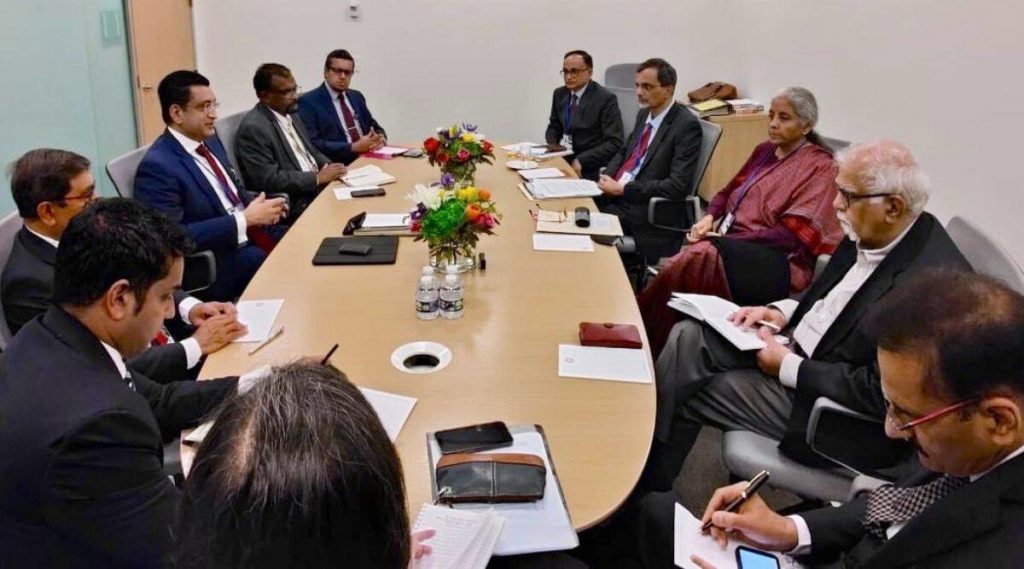Image Courtesy Twitter/Foreign Ministry India
Sri Lanka has taken the (rather delayed) initiative to seek International Monetary Fund (IMF) aid and assistance to cure the economic crisis. Before I delve into what the IMF conditionalities and its impacts are, let me first outline the fundamental challenges faced by the Sri Lankan economy. Firstly, there is an exacerbation of foreign reserves and therefore an urgent necessity to feed the treasury with foreign exchange; the balance of payments crisis (which has now become a humanitarian crisis) has too been offset by this. Additionally, Sri Lanka has had no access to any capital markets ever since the country started defaulting on its loan repayments. So, what is Sri Lanka’s action plan? Currently the government has petitioned for a loan from the IMF because Sri Lanka is currently relying on a few creditors and credit life lines from India. This is what the government is managing with.
The IMF has suggested what is called an Extended Fund Facility (EFF), in response to Sri Lanka’s request to borrow a loan. The EFF is generally suggested for longer term borrowing.
The process of acquiring IMF loans is a long and tedious procedure that calls for complete cooperation and commitment from the Sri Lankan government. Conditionalities have to be set and Sri Lanka’s debt has to be restructured by the IMF board before loans can be agreed upon. The acquisition of the IMF loan is heavily dependent on the condition that Sri Lanka restructures her debt. The government is currently on the path to restructuring debt; so what does this entail? It primarily entails negotiations with Sri Lanka’s bi-lateral creditors such as China and Japan and multilateral institutions such as the Asian Development Bank and the World Bank. The purpose of the negotiation is to come to a consensus with Sri Lanka’s range of creditors to agree that the loans cannot be repaid immediately and to negotiate lower rates on interest or a reduction of the repayment. Arriving at this agreement with all the creditors is a protracted process but a vital aspect of the debt restructuring. To make the process easier, Sri Lanka’s creditors need to have prior knowledge that the government is engaged in talks with the IMF because this gives them reassurance that the Lankan economy is on the path to stabilization with the IMF.
So what is the aim of IMF lending? Typically, the Government of Sri Lanka sought IMF assistance to stabilize the economy. By stabilizing it means attempting to reduce inflation, eliminating the balance of payments crisis, eliminating the exchange rate crisis and fundamentally implementing a recovery program. Sri Lanka is currently in the midst of negotiations with the IMF, battling out conditionalities and amendments to the political and economic status quo. In order to secure the massive loan, the IMF requires their borrowers to have a fiscal surplus; this means that the countries borrowing should earn more than they spend, (thus prompting Sri Lanka to focus on her export sector). There should ideally be a surplus for the economy to be stable, and political stability. Political stability is an extremely important pre-requisite for the IMF funding. Whilst Sri Lanka’s recovery is heavily contingent on approval of the IMF loan, and has no alternative recovery scheme, broad intervention of the IMF into various sectors of a borrower nation can also prove counter-productive. For example, Africa’s relationship with the IMF that began in the 1980s and 90s greatly hindered the growth of labor markets and trade policy. The IMF conditionalities (that should have been prescribed to fiscal and monetary policies) began seeping into the structures of other sectors. This was amended.
All of us can agree that the economic collapse of Sri Lanka is due in part to political failures, lapses and greed. So are there possibilities for the IMF conditionalities to help de-contaminate Sri Lankan politics? For instance, can multilateral donors be persuaded to pursue more anti-corruption investigations?
Yes. One topic the IMF is deeply engaged with is restoring the independence of the Central Bank, because Sri Lanka hasn’t had that. The IMF is insisting on the autonomy of the Central Bank so their sphere of focus is removing government intervention in the treasury as much as possible. What we are all expecting is that the IMF loan will entail regime change but that is idealistic and cannot be instituted through conditionalities from multilateral donors such as the World Bank or the IMF.
Another concern raised by the government during the negotiations is, can the terms of the Extended Fund Facility from the IMF be altered or renegotiated or revised in the future?
Sri Lanka’s economic crisis has now become a humanitarian one where the country is simply in need of foreign exchange to bring in food, medicine and other essential goods. But when a borrower becomes heavily dependent, the IMF does quarterly reviews of how well the debt is being restructured. The loan can only be renegotiated or revised if it can’t be paid back. This happened in 2018 when Argentina borrowed $50 billion (the largest loan the IMF has lent) and defaulted on its repayment. So there is room for revision. But given the fluidity of Sri Lankan politics the debt restructuring is going to include a solid guarantee that the loan can be re-paid and not defaulted on.
Conclusively, there are many social justice warriors who are raising concerns of how the IMF loan and its conditionalities can impact women, lower middle income families and welfare dependent groups in society. However, in the predicament that Sri Lanka finds itself in, it is near impossible to solve the debt crisis and end hyperinflation without the financial aid and assistance of multilateral partners such as the IMF and the World Bank. Sri Lanka’s bilateral donors such as China have also aided the crisis but the strings that are attached to those loans are too widely cast to be heavily dependent on it.
